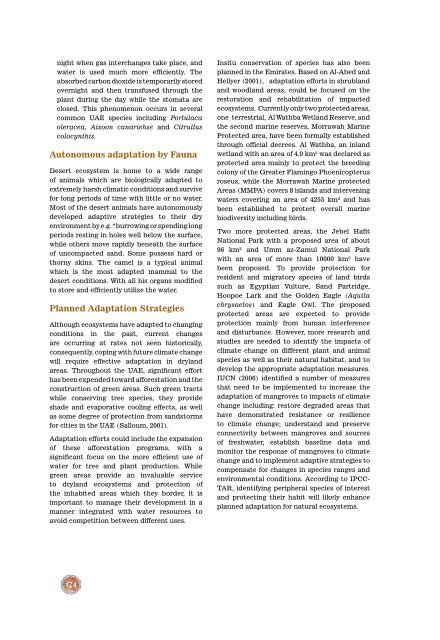climate change on UAE - Stockholm Environment Institute-US Center
climate change on UAE - Stockholm Environment Institute-US Center
climate change on UAE - Stockholm Environment Institute-US Center
Create successful ePaper yourself
Turn your PDF publications into a flip-book with our unique Google optimized e-Paper software.
night when gas inter<str<strong>on</strong>g>change</str<strong>on</strong>g>s take place, and<br />
water is used much more efficiently. The<br />
absorbed carb<strong>on</strong> dioxide is temporarily stored<br />
overnight and then transfused through the<br />
plant during the day while the stomata are<br />
closed. This phenomen<strong>on</strong> occurs in several<br />
comm<strong>on</strong> <strong>UAE</strong> species including Portulaca<br />
oleracea, Aizo<strong>on</strong> canariehse and Citrullus<br />
colocynthis.<br />
Aut<strong>on</strong>omous adaptati<strong>on</strong> by Fauna<br />
Desert ecosystem is home to a wide range<br />
of animals which are biologically adapted to<br />
extremely harsh climatic c<strong>on</strong>diti<strong>on</strong>s and survive<br />
for l<strong>on</strong>g periods of time with little or no water.<br />
Most of the desert animals have aut<strong>on</strong>omously<br />
developed adaptive strategies to their dry<br />
envir<strong>on</strong>ment by e.g. “burrowing or spending l<strong>on</strong>g<br />
periods resting in holes well below the surface,<br />
while others move rapidly beneath the surface<br />
of uncompacted sand. Some possess hard or<br />
thorny skins. The camel is a typical animal<br />
which is the most adapted mammal to the<br />
desert c<strong>on</strong>diti<strong>on</strong>s. With all his organs modified<br />
to store and efficiently utilize the water.<br />
Planned Adaptati<strong>on</strong> Strategies<br />
Although ecosystems have adapted to changing<br />
c<strong>on</strong>diti<strong>on</strong>s in the past, current <str<strong>on</strong>g>change</str<strong>on</strong>g>s<br />
are occurring at rates not seen historically,<br />
c<strong>on</strong>sequently, coping with future <str<strong>on</strong>g>climate</str<strong>on</strong>g> <str<strong>on</strong>g>change</str<strong>on</strong>g><br />
will require effective adaptati<strong>on</strong> in dryland<br />
areas. Throughout the <strong>UAE</strong>, significant effort<br />
has been expended toward afforestati<strong>on</strong> and the<br />
c<strong>on</strong>structi<strong>on</strong> of green areas. Such green tracts<br />
while c<strong>on</strong>serving tree species, they provide<br />
shade and evaporative cooling effects, as well<br />
as some degree of protecti<strong>on</strong> from sandstorms<br />
for cities in the <strong>UAE</strong> (Salloum, 2001).<br />
Adaptati<strong>on</strong> efforts could include the expansi<strong>on</strong><br />
of these afforestati<strong>on</strong> programs, with a<br />
significant focus <strong>on</strong> the more efficient use of<br />
water for tree and plant producti<strong>on</strong>. While<br />
green areas provide an invaluable service<br />
to dryland ecosystems and protecti<strong>on</strong> of<br />
the inhabited areas which they border, it is<br />
important to manage their development in a<br />
manner integrated with water resources to<br />
avoid competiti<strong>on</strong> between different uses.<br />
Insitu c<strong>on</strong>servati<strong>on</strong> of species has also been<br />
planned in the Emirates. Based <strong>on</strong> Al-Abed and<br />
Hellyer (2001), adaptati<strong>on</strong> efforts in shrubland<br />
and woodland areas, could be focused <strong>on</strong> the<br />
restorati<strong>on</strong> and rehabilitati<strong>on</strong> of impacted<br />
ecosystems. Currently <strong>on</strong>ly two protected areas,<br />
<strong>on</strong>e terrestrial, Al Wathba Wetland Reserve, and<br />
the sec<strong>on</strong>d marine reserves, Morrawah Marine<br />
Protected area, have been formally established<br />
through official decrees. Al Wathba, an inland<br />
wetland with an area of 4.9 km² was declared as<br />
protected area mainly to protect the breeding<br />
col<strong>on</strong>y of the Greater Flamingo Phoenicopterus<br />
roseus, while the Morrawah Marine protected<br />
Areas (MMPA) covers 8 islands and intervening<br />
waters covering an area of 4255 km² and has<br />
been established to protect overall marine<br />
biodiversity including birds.<br />
Two more protected areas, the Jebel Hafit<br />
Nati<strong>on</strong>al Park with a proposed area of about<br />
96 km² and Umm az-Zamul Nati<strong>on</strong>al Park<br />
with an area of more than 10000 km² have<br />
been proposed. To provide protecti<strong>on</strong> for<br />
resident and migratory species of land birds<br />
such as Egyptian Vulture, Sand Partridge,<br />
Hoopoe Lark and the Golden Eagle (Aquila<br />
chrysaetos) and Eagle Owl. The proposed<br />
protected areas are expected to provide<br />
protecti<strong>on</strong> mainly from human interference<br />
and disturbance. However, more research and<br />
studies are needed to identify the impacts of<br />
<str<strong>on</strong>g>climate</str<strong>on</strong>g> <str<strong>on</strong>g>change</str<strong>on</strong>g> <strong>on</strong> different plant and animal<br />
species as well as their natural habitat, and to<br />
develop the appropriate adaptati<strong>on</strong> measures.<br />
IUCN (2006) identified a number of measures<br />
that need to be implemented to increase the<br />
adaptati<strong>on</strong> of mangroves to impacts of <str<strong>on</strong>g>climate</str<strong>on</strong>g><br />
<str<strong>on</strong>g>change</str<strong>on</strong>g> including: restore degraded areas that<br />
have dem<strong>on</strong>strated resistance or resilience<br />
to <str<strong>on</strong>g>climate</str<strong>on</strong>g> <str<strong>on</strong>g>change</str<strong>on</strong>g>; understand and preserve<br />
c<strong>on</strong>nectivity between mangroves and sources<br />
of freshwater, establish baseline data and<br />
m<strong>on</strong>itor the resp<strong>on</strong>se of mangroves to <str<strong>on</strong>g>climate</str<strong>on</strong>g><br />
<str<strong>on</strong>g>change</str<strong>on</strong>g> and to implement adaptive strategies to<br />
compensate for <str<strong>on</strong>g>change</str<strong>on</strong>g>s in species ranges and<br />
envir<strong>on</strong>mental c<strong>on</strong>diti<strong>on</strong>s. According to IPCC-<br />
TAR, identifying peripheral species of interest<br />
and protecting their habit will likely enhance<br />
planned adaptati<strong>on</strong> for natural ecosystems.<br />
174










